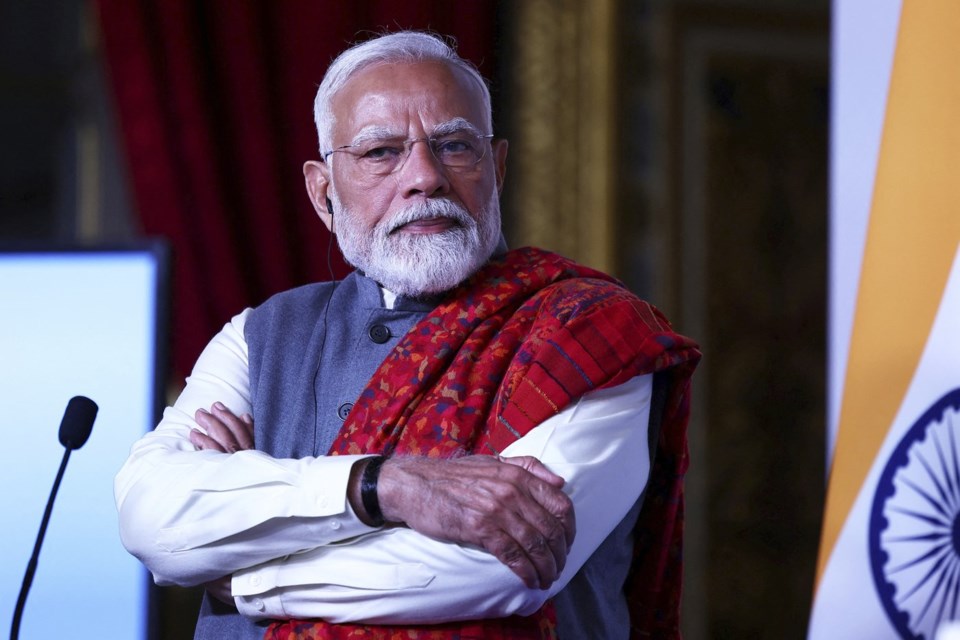WASHINGTON (AP) — President Donald Trump met Thursday with Indian Prime Minister Narendra Modi, who has heaped praise on him in hopes of avoiding the additional tariffs that the new administration has slapped on other countries in its opening weeks.
Trump and Modi greeted each with a hug in the lobby of the West Wing before meeting Thursday afternoon in the Oval Office. Trump called Modi a “great friend” hours after signing an order to increase tariffs to match the tax rates that other countries charge on imports, which affects American trading partners around the world, including India.
“We have great friendship, he and I and our countries, and I think it’s only going to get closer,” Trump said.
Modi is a nationalist and spent his time before arriving in Washington talking up his warm relationship with Trump during his first term while cheering his winning back the White House. The Indian leader was looking to improve relations with Washington and the West overall, which have been frosty lately after Modi refused to condemn Russia for its war on Ukraine.
“The world had this thinking that India somehow is a neutral country in this whole process,” Modi said, praising Trump for speaking with Russia and Ukraine's leaders on Wednesday. “But this is not true. India has a side, and that side is of peace.”
The trip comes after Modi's ruling Hindu nationalist party’s victory during a high-stakes state legislature election last weekend in India’s federal territory, including New Delhi. The prime minister said before leaving for Washington that the visit was a chance to “deepen our partnership” in key areas such as technology, trade, defense and energy.
The White House visit isn't likely to be all smiles, though.
Trump, a Republican, previously imposed tariffs on China and says more are coming against the European Union, while threatening similar against Canada and Mexico and expanding tariffs on steel and aluminum he initially imposed during his first term.
The White House insists that in signing Thursday's round of what Trump called “reciprocal" tariffs, he is leveling the playing field between U.S. manufacturers and foreign competitors — though these new taxes would likely be paid by American consumers and businesses either directly or in the form of higher prices.
Even prior to signing the new round of tariffs, however, Trump indicated that he was ready to object to Indian tariffs. He repeatedly dubbed Modi's country a “tariff king.”
In response, New Delhi showed willingness to buy more American oil and lower its own tariffs on U.S. goods, including on some Harley-Davidson motorcycles, from 50% to 40% — moves it took prior to Modi's coming to Washington.
Also, India in 2023 dropped retaliatory tariffs on U.S. almonds, apples, chickpeas, lentils and walnuts.
Then there's a recent deal allowing U.S.-based General Electric to partner with India-based Hindustan Aeronautics to produce jet engines for Indian aircraft in India, and the sale of U.S.-made armed MQ-9B SeaGuardian drones.
Still, Trump has decried U.S. trade deficits around the world and said he'll work to shrink them, including during his meetings at the White House last week with Japanese Prime Minister Shigeru Ishiba.
The U.S. is India’s largest trade partner, but the two countries have a trade deficit of $50 billion in India’s favor.
The Indo-U.S. goods and services trade totaled around $190.1 billion in 2023. According to India’s External Affairs Ministry, the U.S. exports to India were worth nearly $70 billion and imports $120 billion.
A Trump administration official, on a phone call with reporters, said that India has made modest positive steps on trade. The official, who insisted on anonymity as a term of the call, said there is a goal of finalizing by the end of this year a trade arrangement with India that the United States would judge as fair to both sides.
Modi is the fourth foreign leader to visit Trump since his inauguration last month, following Israeli Prime Minister Benjamin Netanyahu, Ishiba of Japan and Jordan's King Abdullah II.
Prior to meeting with Trump, Modi sat down with national security adviser Mike Waltz. He also met with billionaire SpaceX founder and top Trump administration official Elon Musk.
In a photo posted to Modi's account on X, the platform owned by Musk formerly known as Twitter, the prime minister, joined by his official delegation, was seen engaging warmly in conversation with Musk, who brought some of his children and an executive, Shivon Zilis, who is also the mother of three of his children.
While signing the tariffs order in the Oval Office, Trump was asked if Musk spoke with Modi as a government worker or a tech magnate, amid concerns the meeting was related to the billionaire’s business dealings.
“India is a very hard place to do business because of the tariffs. They have the highest tariffs, just about in the world, and it’s a hard place to do business," Trump said. "No, I would imagine he met possibly because, you know, he’s running a company.”
Modi and Trump were also likely to use their upcoming discussions to talk about immigration. There, the prime minister can point to India's having accepted the return of 104 migrants brought back on a U.S. military plane — the first such flight to the country as part of the Trump administration's crackdown on immigration and the U.S.-Mexico border.
For the Trump administration, meanwhile, India is seen as integral to the U.S. strategy of containing China in the Indo-Pacific. Modi's country is hosting a summit of a group of countries known as the Quad — made up of the U.S., India, Japan and Australia — later this year.
Will Weissert, The Associated Press



